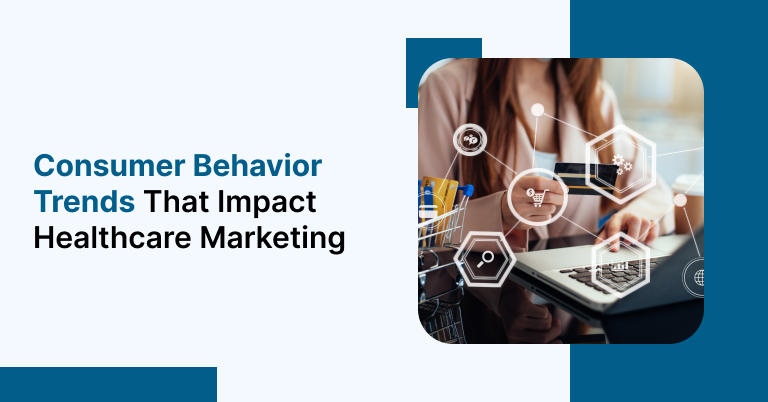
Consumer Behavior Trends that impact Healthcare Marketing
In the evolving sector of Healthcare marketing, changes and transformations in technologies, strategies, and approaches are driven by demands and consumer behavior trends. It is important to keep up with current marketing trends to attract new customers and build up trust and credibility to maintain good relationships with existing customers.
Following are the current trends in consumer behavior in healthcare that have a major impact on healthcare marketing.
Greater Priority for Digital Functionality
Virtual healthcare has become normalized these days and is a preferred choice for most healthcare consumers. In a recent survey, over 70% of people prefer digital healthcare services with their hospitals or doctors over direct communication.
More than two-thirds of people choose to use mobile apps for their appointments, payments, and other healthcare scheduling. At the same time, people prefer to use different digital devices like smartwatches, biosensors, fitness trackers, and other wearable devices to monitor and report health data to professionals.
Customer Buying Behaviour in Healthcare:
Customer buying behavior in healthcare can be seen when a patient looks for treatment for a chronic condition like diabetes. The patient usually begins by reading articles, watching videos, and browsing the internet for various treatment choices in order to gain more knowledge about diabetes management.
Additionally, they might concentrate on medical professionals who specialize in diabetes treatment and have received good feedback from previous patients, which would aid them in selecting a reputable and experienced provider.
Consumer Satisfaction is the Key
It is important to satisfy the consumers and provide the high-quality care they deserve. They act as a medium in building the brand’s trust and credibility through positive word-of-mouth or in the form of referrals. Consumer reviews and ratings not only increase the online reputation of the brand but also increase the revenue.
Consumer satisfaction and retention rates go hand in hand, forming a solid foundation for the brand’s supporters. Success stories and testimonials are evidence of positive healthcare services, which instill confidence and trust, attracting new audiences to the brand.
Example of Consumer Behavior in Healthcare:
A very good example is many patients take their time selecting a healthcare practitioner for procedures like IVF. If IVF is something you’re thinking about, you could start by researching clinics online, reading reviews, and comparing success rates. To feel confident and well-informed about your decision, you will likely concentrate on clinics with high ratings, satisfied patients, and transparent information about fees and procedures.
Enhanced Convenience through Digital Health
According to the data, 84.7 % of people are open to home health services, which have been constantly expanding their market since 2019. Due to the growing demand for healthcare services at home, it is significant to draft a strategy that takes a one-size-fits-all approach.
Digital health is the most desired choice of people nowadays because it involves personal care, familiarity with the environment, and active family participation.
Virtual care options make it easy for older adults and people between other age groups to connect with healthcare professionals remotely, removing the requirement of face-to-face meetings.
AI-driven customization for Healthcare Marketing
AI-powered analytics provide a detailed data analysis report of consumer behavior in healthcare and their preferences. These insights give a significant advantage in product development, sales forecasting, and marketing strategies. AI also aids in targeting consumers with specific campaigns and emerging trends while recognizing market gaps.
Processing the vast amount of consumer data in healthcare requires AI algorithms for effective interpretation. At the same time, it manages the medical records of the consumers and provides customer support using chatbots regarding the relevant queries of the consumers.
User Experience matters the most
It is essential to have a well-designed, responsive website that encourages active engagement from patients and providers and is always relevant. The healthcare website design should be user-friendly and include every other detail, such as online appointment scheduling, directions, working hours, and emergency contact details.
The website should act as a bridge connecting users and hospitals, providing a range of features, including access to medical records, prescription refills, chat support for any queries, billing records, and other information about healthcare facilities.
The website should be SEO-optimised to match emerging marketing trends and be relatable to consumer behavior in healthcare and their preferences.
Video’s Influence on Patient’s Engagement
Video is a great approach to introducing your business and increasing user interaction. Healthcare videos enable consumers to obtain information about treatments and medical equipment. Videos instantly grab viewers’ attention and compel them to watch and listen to the whole story. Hospitals can create videos on complicated medical procedures, educating consumers, and other content highlighting their services and facilities.
It helps to reach a wider audience, driving patient engagement and enhancing the visitor’s experience. Nowadays, more people are turning to video content to stay informed and engaged. It is also an effective way to introduce products and services in healthcare.
Match the Marketing Trends with us
To improve user experiences and patient outcomes, an organization must first have a greater awareness of the distinctive needs, behaviors, and attitudes of the people it serves. As consumers continue to adopt new technologies and trends, it is crucial to keep up with emerging digital marketing trends.
Contact us today, a healthcare marketing expert, to learn about tailoring the perfect suit that fits your consumer needs and interests, attracts new customers, and strengthens your relationships with existing customers.
Frequently asked question
There are four types of consumer buying behaviour such as
- Complex buying behaviour - It happens when you make a big purchase, like buying a new bike.
- Dissonance - reducing buying behaviour - Purchasing an affordable laptop and looking at reviews for assurance.
- Habitual buying behaviour - Buying the same brand of toothpaste out of habit.
- Variety-seeking buying behaviour - Trying a new snack brand for a change of taste.
Consumer behaviour has a major impact on marketing, as it plays a huge role in helping better understand consumers' wants, needs, and interests. It also helps in planning various business promotional activities and marketing strategies for the target audience.
A consumer behaviour model is a flowchart that explains the steps and variables influencing customers' decision-making about what to buy.
People looks at reviews, insurance coverage, cost, location, and availability of communication while selecting a primary care physician.
Search
Recent Post
Categories
- AI in Healthcare
- Content Marketing
- Dental
- dental Digital Marketing
- Google Ads
- Google my business
- Healthcare marketing
- Healthcare SEO
- Internet Marketing Tips
- Lead Generation
- Local SEO
- Patient Satisfaction
- pay per click
- Pharma Marketing
- Social
- Social Media Marketing
- Traffic
- Website
- Website Designing
Contact
Get in Touch With Us
Coimbatore Address
- 21/1, Periasubbanna Gounder Street, K.K.Pudur, Coimbatore, Tamil Nadu 641038.
- 098942 76263
- info@harveehealthcare.com

Chennai Address
- RMZ Millenia Business Park, Level 6, Phase II, Campus 4B Unit 602A, Kandancavadi, Perungudi, Chennai, Tamil Nadu 600096.
- 098942 76263
- info@harveehealthcare.com

Dubai Address
- Umm Sequeim 3, Jumeirah Rd Opposite Burj Al Arab, Villa #1 855 A Dubai.
- info@harveehealthcare.com

United Kingdom Address
- 3/2 Powderhall Rigg Edinburgh, United Kingdom EH7 4GA.
- info@harveehealthcare.com

Copyrights © 2025 harvee.co.uk











Leave a Reply